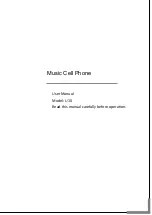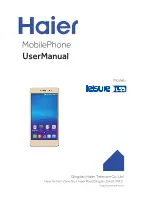
Mitel 6800 Series SIP Phone Release 4.2.0 Administrator Guide
4-87
CUSTOMIZED CODEC PREFERENCE LIST
You can also configure the IP phones to use preferred codecs. To do this, you must enter the
payload value (
payload
), the packetization time in milliseconds (
ptime
), and enable or disable
silence suppression (
silsupp
).
Payload
is the codec type to be used. This represents the data format carried within the RTP
packets to the end user at the destination. The default payload setting is to allow all codecs.
You can set payload to use only basic codecs (G.711 u-Law, G.711 a-Law, G.729), and/or
Adaptive Multi-Rate (AMR) and Adaptive Multi-Rate Wideband (AMR -WB) (G.722.2) codecs
(if a license is available), or select from up to 14 codecs for the phones AND customize a codec
preference list of up to 10 codecs. In the Mitel Web UI, codecs 2 through 10 can be set to “None”
if required (no codecs).
Ptime
(packetization time) is a measurement of the duration of PCM data within each RTP
packet sent to the destination, and hence defines how much network bandwidth is used for
transfer of the RTP stream. You enter the ptime values for the customized codec list in
milliseconds. (See table below).
Silsupp
is used to enable or disable silence suppression. Voice Activity Detection (VAD) on
the IP phones is used to determine whether each individual packet contains useful speech
data. Enabling
silsupp
results in decreased network bandwidth, by avoiding the transmission
of RTP packets for any frame where no voice energy was detected by the VAD.
You must enter the values for this feature in list form as shown in the following example:
payload=8;ptime=10;silsupp=on,payload=0;ptime=10;silsupp=off
Note:
In the Mitel Web UI:
• Setting Codec 1 to “All” ignores the packetization interval (ptime). The packetization
interval setting defaults to 30, which is the default for all codecs.
• Setting Codec 1 to “All” automatically sets all other codec preference fields 2 through
10 to “None”.
• Setting Codec 1 to “Basic” and all other codec preferences in 2 through 10 to “None”,
forces the phone to use only the basic codecs as in previous releases (G.711 u-law,
G.711 a-law, and G.729). If you select an additional codec to use in the codec pref-
erences 2 through 10 fields, those codecs are added to the list of Basic codecs for
the phone to use.
Summary of Contents for 6867i Premium
Page 1: ...Mitel 6800 Series SIP Phones 58014473 REV00 RELEASE 4 2 0 ADMINISTRATOR GUIDE ...
Page 21: ...Chapter 1 OVERVIEW ...
Page 52: ...Chapter 2 CONFIGURATION INTERFACE METHODS ...
Page 71: ...Chapter 3 ADMINISTRATOR OPTIONS ...
Page 154: ...Chapter 4 CONFIGURING NETWORK AND SESSION INITIATION PROTOCOL SIP FEATURES ...
Page 262: ...Chapter 5 CONFIGURING OPERATIONAL FEATURES ...
Page 579: ...Chapter 6 CONFIGURING ADVANCED OPERATIONAL FEATURES ...
Page 654: ...Chapter 7 ENCRYPTED FILES ON THE IP PHONE ...
Page 660: ...Chapter 8 UPGRADING THE FIRMWARE ...
Page 669: ...Chapter 9 TROUBLESHOOTING ...
Page 699: ...Appendix A CONFIGURATION PARAMETERS ...
Page 1003: ...Appendix B CONFIGURING THE IP PHONE AT THE ASTERISK IP PBX ...
Page 1007: ...Appendix C SAMPLE CONFIGURATION FILES ...
Page 1023: ...Appendix D SAMPLE BLF SOFTKEY SETTINGS ...
Page 1027: ...Appendix E SAMPLE MULTIPLE PROXY SERVER CONFIGURATION ...
Page 1042: ......
















































